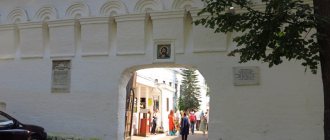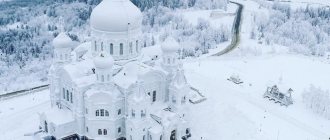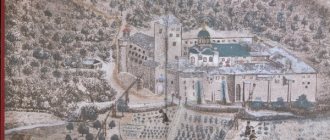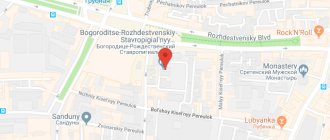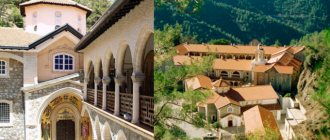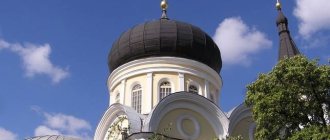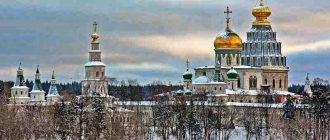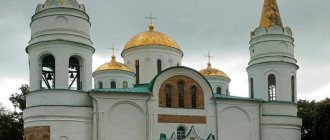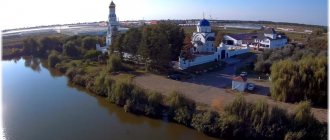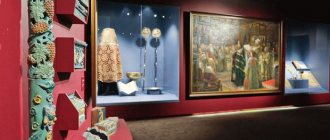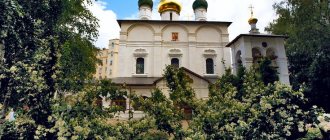Mir
Russia Moscow region Zvenigorod Savvino-Storozhevsky Monastery Map loading in progress...
{"format":"leaflet","minzoom":false,"maxzoom":false,"limit":50,"offset":0,"link":"all","sort":[""], "order":[],"headers":"show","mainlabel":"","intro":"","outro":"","searchlabel":"\u2026 \u0441\u043b\u0435\ u0434\u0443\u044e\u0449\u0438\u0435 \u0440\u0435\u0437\u0443\u043b\u044c\u0442\u0430\u0442\u044b","default":"","import-annotation":false,"width ":"auto","height":"350px","centre":{"text":"","title":"""link":"""lat":55.728566000000000713043846189975738525390625,"lon": 36.81674100000000038335201679728925228118896484375,"icon":""},"title":"","label":"","icon":"","lines":[],"polygons":[],"circles":[ ],"rectangles":[],"copycoords":false,"static":false,"zoom":8,"defzoom":14,"layers":["OpenStreetMap"],"image layers":[] ,"overlays":[],"resizable":false,"fullscreen":true,"scrollwheelzoom":true,"cluster":false,"clustermaxzoom":9,"clusterzoomonclick":true,"clustermaxradius":80, "clusterspiderfy":true,"geojson":"","clicktarget":"","showtitle":true,"hidenamespace":false,"template":"","userparam":"","activeicon": "","pagelabel":false,"ajaxcoordproperty":"","ajaxquery":"","locations":[{"text":"\u003Cb\u003E\u003Ca href=\"/palomnik/%D0% A1%D0%B0%D0%B2%D0%B2%D0%B8%D0%BD%D0%BE-%D0%A1%D1%82%D0%BE%D1%80%D0%BE%D0%B6 %D0%B5%D0%B2%D1%81%D0%BA%D0%B8%D0%B9_%D0%BC%D0%BE%D0%BD%D0%B0%D1%81%D1%82%D1 %8B%D1%80%D1%8C\" title=\"\u0421\u0430\u0432\u0432\u0438\u043d\u043e-\u0421\u0442\u043e\u0440\u043e\u0436\u0435\u0432\u0441\ u043a\u0438\u0439 \u043c\u043e\u043d\u0430\u0441\u0442\u044b\u0440\u044c\»\u003E\u0421\u0430\u0432\u0432\u0438\u043d\u043e-\ u0421\u0442\u043e\u0440 \u043e\u0436\u0435\u0432\u0441\u043a\u0438\u0439 \u043c\u043e\u043d\u0430\u0441\u0442\u044b\u0440\u044c\u003C/a\u003E\u003C /b\u003E","title ":"\u0421\u0430\u0432\u0432\u0438\u043d\u043e-\u0421\u0442\u043e\u0440\u043e\u0436\u0435\u0432\u0441\u043a\u0438\u0439 \u04 3c\u043e\u043d\u0430 \u0441\u0442\u044b\u0440\u044c","link":"","lat":55.728566000000000713043846189975738525390625,"lon":36.81674100000000038335201679728 925228118896484375,"icon":""}],,"imageLayers":[]}
55.729037; 36.816392
Russia, Moscow region, Odintsovo urban district, Zvenigorod, Ratekhinskoe highway, 9
Zvenigorod, Moscow region
Russia
Telephone:
(reception room of the governor); 8(903)274-01-21 (pilgrimage department), 8(963)640-37-00 (hotel).
Email:
; and (hotel).
Savvino-Storozhevsky Monastery
- Orthodox monastery of the Moscow diocese. Founded at the end of the 14th century, it is located on Mount Storozhi at the confluence of the Storozhka River with the Moscow River, two kilometers west of the city of Zvenigorod, Moscow Region.
Some historians claim that Tsar Alexei Mikhailovich gave the Savvino-Storozhevsky Monastery the status of the first monastery in Russia (in terms of importance and number), and only then did the Kiev-Pechersk and Trinity-Sergius monasteries receive the same status.
History[edit]
The monastery was founded in 1398 by the monk Savva, a disciple of St. Sergius of Radonezh, at the request and with the support of the Zvenigorod prince Yuri Dimitrievich. At first, a wooden church was built in the name of the Nativity of the Blessed Virgin Mary. It was located on the high mountain Storozhi, in view of the Moscow River - the main transport route to the west from Moscow at that time, at the mouth of the Rozvadni river, later called Storozhka. For privacy, Savva dug a cave in which he spent time in prayer. At first, the area of the monastery was small, but over time the number of monks grew, and the territory of the monastery increased significantly.
From the very foundation of the Savvino-Storozhevsky Monastery, Prince Yuri Dmitrievich took care of it, trying to turn it into his court monastery. Already in the first years of its existence at the beginning of the 15th century. (1402) the monastery received from the Zvenigorod prince extensive possessions in the immediate vicinity of the city: the villages of Belgino, Dubatsino and Ust-Rozvadnya with villages adjacent to them, as well as huge forests in the south of the City camp (the village of Ust-Rozvadnya on the other side of Rozvadnya later became a sub-monastery and began to be called Savvinskaya Sloboda).
In the XV-XVII centuries, the Savvino-Storozhevsky Monastery played the role of a military outpost of the Moscow Principality in the west. The monastery was a favorite place of prayer for many Russian tsars. In particular, Ivan IV the Terrible and his wife Anastasia Romanovna, as well as their son Feodor Ioannovich, came here. Under Tsar Alexei Mikhailovich, the monastery became a country royal residence. The palace of the empress and the royal chambers were erected here. At the same time, the monastery was surrounded by stone walls. The temples of the monastery were painted by icon painters from the Armory Chamber of the Moscow Kremlin. Archimandrite Nikanor (1654-1658) subsequently became the archimandrite of the Solovetsky Monastery, where he led the Solovetsky uprising in defense of the Old Faith.
The Zvenigorodsky tract was laid from Moscow to the Savvino-Storozhevsky Monastery, which was also known as the Tsar’s Road or the Road of God’s Chosen Kings; all Russian rulers: grand dukes, tsars and emperors made obligatory pilgrimages to the monastery to the relics of Savva Storozhevsky more than once. In the first half of the 20th century, this road was called Zvenigorodskoe Highway, but now it is better known as Rublevo-Uspenskoe Highway or simply Rublyovka.
During the Patriotic War of 1812, the Moscow vicar Bishop Augustin (Vinogradsky) went from the Savvino-Storozhevsky Monastery to pray for the Moscow militia. Russian shrines were taken out of the monastery - the Vladimir and Iveron icons of the Mother of God - for public prayer for the protection of the Russian land. The monastery, occupied by the French, was not plundered: according to legend, the Monk Savva appeared to the French commander Eugene Beauharnais and ordered not to touch the monastery.
In 1917, the future martyr Dimitri (Dobroserdov) was appointed rector of the monastery. In May 1918, Konstantin Ivanovich Makarov arrived here with the mandate of food commissar. His detachment requisitioned bread from the Savvino-Storozhevsky Monastery, and at the same time tried to open the shrine containing the relics of St. Savva Storozhevsky - which became the reason for the “Zvenigorod rebellion”. Participants in the rebellion killed Makarov and two other communists, but an armed detachment from Dedovsk that soon arrived suppressed the uprising... In mid-1919, the monastery was closed. In 1941, during the evacuation, the unique 35-ton Great Annunciation Bell (depicted on the coat of arms of Zvenigorod) was destroyed, the ringing of which, according to eyewitnesses, reached Moscow (at the beginning of the 21st century, another, equally massive one was installed to replace this bell). In 1986, the wooden hipped roof of one of the monastery towers burned down.
On February 9, 1995, an agreement was signed between the Administration of the Moscow Region and the Moscow Patriarchate on the joint use of part of the monastery buildings by the Zvenigorod Historical, Architectural and Art Museum and the reviving monastery, and the monastery itself received stauropegial status.
Founders of the Savvino-Storozhevsky Monastery
At the origins of the monastery stood Savva Storozhevsky and Prince Yuri Dmitrievich.
The latter was the third son of Dmitry Donskoy. His father gave him Zvenigorod, where he began to reign. Yuri Dmitrievich was distinguished by his piety. His godfather was Sergius of Radonezh. Savva is one of the first students of the miracle worker. Subsequently, he became the spiritual mentor of the family of Dmitry Donskoy, including his son. Not much is known about Savva before his arrival in Zvenigorod: he came from a wealthy, most likely boyar family, took monastic vows at the Trinity Monastery, and after the death of Sergius of Radonezh he ruled it for six years.
According to chronicles from 1395, Savva gave his blessing to Prince Yuri to go to Volga Bulgaria. He returned home victorious, having captured 14 cities, including Kazan. To celebrate, the prince allocated funds for the construction of a temple on the deserted Zvenigorod hill of Storozhe as a token of gratitude. Savva blessed the construction.
Current state[edit]
Today there are 50 inhabitants in the monastery. Over the past years, the 17th-century iconostasis has been restored and the frescoes have been restored.
In August 1998, the 600th anniversary was celebrated at the Savvino-Storozhevsky Monastery. His Holiness Patriarch Alexy II, after the Liturgy at the Moscow St. Daniel Monastery, solemnly transported the relics of the Monk Savva, the founder of the monastery, to Zvenigorod. In 2007, a monument to St. Savva was unveiled.
The monastery prepares the legendary kvass, infused with raisins (giving additional “wine” fermentation). It is planned to open a Museum of Church Wine at the monastery (in a special building outside the main territory).
Status now
Today about 30 monks live in the monastery. In addition to monastic service, they are also engaged in social activities.
The monastery operates:
- Children's shelter. It is located in Zvenigorod itself. Up to 30 children live here. Some undergo rehabilitation courses at the center at the shelter. In total, the shelter released about 100 people during its operation. In addition to general subjects, children study Orthodoxy and Church Slavonic. It is noteworthy that the work is carried out exclusively on voluntary donations to the monastery.
- Publishing house. The monastery has its own publishing house, which produces theological books, works by various authors, postcards dedicated to the monastery, and the magazine “Savvinskoye Slovo”.
They also conduct theological courses for people over 17 years of age. In total, 11 disciplines are taught here, including Holy Scripture, dogmatic theology, basic theology, general church history, and history of the Russian Church. Training is free, based on an interview. In addition, participants regularly go on pilgrimage trips.
At the beginning of the 20th century, the Savvinskoye Metochion was opened in Moscow on Tverskaya Street. Today it is occupied by commercial firms and surrounded on all sides by new buildings. Interesting fact: in 1939, during the expansion of the street, it was necessary to move the building deeper. This was done at night in November 1939 without evicting the residents.
Buildings and structures[edit]
Cathedral of the Nativity of the Virgin Mary, early 15th century
Temples[edit]
- Nativity of the Virgin Mary Cathedral (the traditional date of construction - 1405 - is disputed), later the Savvinsky (southern) chapel, a double-sided porch and a sacristy were added to the cathedral, the kokoshniks were recreated by Soviet restorers;
- The Gate Church of the Life-Giving Trinity was built by I.M. Sharutin in 1650;
- Church of St. Sergius of Radonezh in the bell tower;
- Church of St. Alexis, the man of God;
- Refectory Church, Temple of the Transfiguration of the Lord (built in 1695 by order of Princess Sophia).
Other buildings[edit]
- The refectory (1652-1654) is a four-story building, which Pavel of Aleppo described with admiration. The old refectory and the Holy Gate, found during excavations, were built in the 16th century.
Royal Chambers
- The Tsarina's Chambers (1652-1654). The palace was built for Tsarina Maria Ilyinichna Miloslavskaya, the first wife of Tsar Alexei Mikhailovich. Until 1828, this one-story building with a basement had a second wooden floor. The building is divided into front and utility halves. The front half consists of three parts with separate entrances: the central part is for the queen, the side parts are for the retinue. In the utility half, a suite of rooms runs through the entire building.
- The palace of Tsar Alexei Mikhailovich was built in three stages. In 1652-1654. The northern part of the palace was built. In 1674-1676. The palace became a one-story building on a basement of seven cages with separate entrances about one hundred meters long. The front central part was occupied by the king's chambers, in the northern part there were kitchen premises, the remaining cells were intended for the royal family and retinue. The four cages had a wooden second floor, where narrow staircases inside the walls led. In 1686-1687 Under Princess Sophia, the roof and planked towers were dismantled and a second floor was built with a suite of rooms along the entire length of the building. Instead of internal staircases, external stone porches were built to the second floor. The palace was badly damaged in the fire of 1742.
- The brethren's buildings (mid-17th century), the habitat of the monks, were repeatedly completed and rebuilt.
- Residential building of theological schools designed by D. F. Borisov (1820s) on the site of the Treasury building.
- The belfry has a four-tier structure, which is crowned with four stone tents with domes.
Towers[edit]
The fortress was built according to the royal decree under the leadership of N. M. Boborykin and A. Shakhov.
In the monastery, I.M. Sharutin, who also built the walls of the Trinity Kalyazin Monastery, built seven towers in 1650-1654, six have survived to this day.
- Red (above the Holy Gate)
- Zhitnaya
- Vodovzvodnaya
- Usovaya
- Sick leave (not preserved)
Patronal holidays[edit]
Nativity of the Blessed Virgin Mary
- September 21
The following four holidays are associated with the memory of St. Savva of Storozhevsky:
December 16 is the day of the saint’s righteous death in 1407;
February 1 - discovery of holy relics in 1652;
July 30 - transfer of holy relics and placing them under a new canopy in 1847;
August 23 - the second discovery and transfer of holy relics from the Moscow St. Danilov Monastery to the Savino-Storozhevsky Monastery in 1998.
Monk Sava's Skete
To pray in solitude, the Monk Savva often moved away from the monastery into a ravine. Later, at this place, he dug a cave in which he had the opportunity to talk with the Lord one-on-one. After his death, a church with cells and outbuildings, the so-called Skete, was erected on the site of the cave.
People who were looking for peace of mind often came to the Skete. Sava's monastery was visited by princes and emperors, in particular Tsar Alexander II and Grand Duke Sergei Alexandrovich.
During Soviet times, the monastery suffered greatly. Most of the buildings were destroyed, and those that survived were allocated for housing to the families of military personnel. Only for the 600th anniversary of the monastery was the restoration of the Skete carried out, the work of the source resumed, and a bathhouse built.
How to get there[edit]
Address:
Moscow region, Zvenigorod (Odintsovo district), Gorodok, 5.
Directions:
You can get to Zvenigorod by bus from the Kuntsevo metro station or by train from the Belorussky railway station. Zvenigorod station is the final station of the side branch; trains go there infrequently (on average once every 1.5 hours), so when planning your trip, find out the schedule. The station is located outside of Zvenigorod; you still need to get to the city or its environs. Buses run from the station, the departure of which is synchronized with the train schedule. Routes No. 23 and 51 follow to the monastery.
Telephone:
(reception room of the governor); 8(903)274-01-21 (pilgrimage department), 8(963)640-37-00 (hotel).
Email:
; and (hotel).
